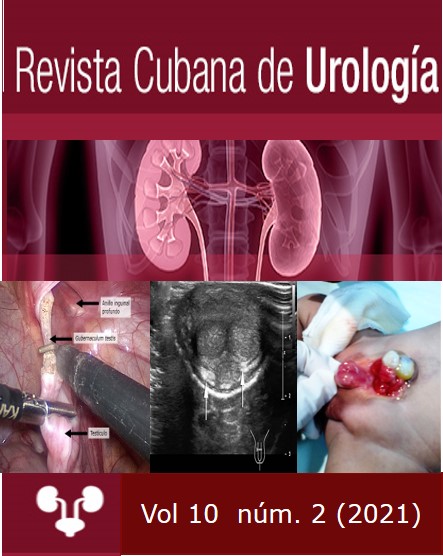Bladder Exstrophy and Maternal-Fetal Ultrasound
Keywords:
bladder exstrophy, ultrasound, diagnosis.Abstract
Introduction: Maternal-fetal ultrasound is one of the advances in radiological science and technique. It is considered a reliable tool in the diagnosis of bladder exstrophy.
Objective: Identify the diagnosis of bladder exstrophy by maternal-fetal ultrasound.
Method: A retrospective analysis is presented on 26 Cuban children diagnosed with bladder exstrophy treated in the Urology Service of "William Soler" Teaching Pediatric Hospital from January 1, 1996 to December 31, 2015.
Results: Of the 26 patients studied, 24 (92.4%) were not diagnosed with bladder exstrophy by maternal-fetal ultrasound. It was found in the physical examination at birth. Only two children (7.6%) had a positive prenatal diagnosis of bladder exstrophy.
Conclusions: It is necessary to focus attention on the thorough search for bladder exstrophy in the first 12 weeks of gestation when conducting studies, such as fetal maternal ultrasound, in order to rule out the presence of described ultrasound signs and the repeated absence of bladder filling suggesting a bladder disorder.
Downloads
References
2. Garmel SH, D´Alton ME. Diagnostic Ultrasound in pregnancy; an overview. Semi. Perinatal. 1994 [acceso 10/05/2020];18(3):117-32. Disponible en: https://pubmed.ncbi.nlm.nih.gov/7973782/
3. Goncalves LF, Hill H, Bailey S. Prenatal and postnatal imaging techniques in the evaluation of disorders of sex development. Sem Ped Surg. 2019 [acceso 10/05/2020];28(5):150839. DOI: https://doi.org/10.1016/j.sempedsurg.2019.150839
4. Yang QX, Xiao HY, Xin LC, Xiu QJ, Sheng Z Misdiagnosis of a cloacal exstrophy variant as urorectal septum malformation in a fetus by ultrasound: A case report. Exp & Therap Med. 2017 [acceso 11/05/2020];14(2):1665-8. Disponible en: https://www.ncbi.nlm.nih.gov/pmc/articles/PMC5526091/
5. Cervellione RM, Mantovani A, Gearhart J, Bogaert GC, Gobet R, Caione P, Dickson AP. Prospective study on the incidence of bladder/cloacal exstrophy and epispadias in Europe. J of Ped Urol. 2015;11(6):337.01-337.06. DOI: http://dx.doi.org/10.1016/j.jpurol.2015.03.023
6. Wein AJ, Kavoussi LR, Novick AC, Partin AW, Peters CA. Campbell-Walsh-Urology. 12va. ed. Madrid. Elsevier inc. 2020 [CD-ROM]; p. 538.
7. Torres SU, Portela Oliveira E, Braojos Braga FC, Jr HW. When closure Fails: What the Radiologist Needs to Know About the Embryology, Anatomy, and Prenatal Imaging of Ventral Body Wall Defects. Sem in US, CT & MRI 2015;36(6):522-35. DOI: http://dx.doi.org/10.1053/j.sult.2015.01.001
8. Toledo Martínez E, Leyva Calafell M, Barroso Sánchez G, León Ramos, Boffil Falcón A, Noalla Parets DL. Complejo extrofia vesical-epispadias. Reporte de un caso. Rev Med Electrón. 2018 [acceso 11/05/2020];40(3):1684-824. Disponible en: http://scielo.sld.cu/scielo.php?script=sci_arttext&pid=S1684-18242018000300022
9. Mercado J, Márquez R, Bachaman M, Soto A, González P. Extrofia vesical. Diagnóstico prenatal. Revista Chilena de Ultrasonografía. 2014 [acceso 11/05/2020];17(1):8. Disponible en: http://www.sochumb.cl/wp-content/uploads/2014/11/US-17-1-2014.pdf
10. Rodríguez K, Vélez S. Extrofia vesical en un neonato y su relación otras manifestaciones congénitas. Revista Médica De Honduras. 2012 [acceso 10/05/2020];80(4). Disponible en: http://www.bvs.hn/RMH/pdf/2012/pdf/Vol80-4-2012-8.pdf
11. Gómez Méndez G, Rodrigo Beal J. Imagen in Medicine. Bladder Exstrophy. Revista Asociación Médica Brasil. 2016 [acceso 11/05/2020];62(3):197-8. Disponible en:
https://www.scielo.br/pdf/ramb/v62n3/0104-4230-ramb-62-3-0197.pdf
12. Silva González GK, Reyes Reyes E, Ochoa Hidalgo A y Hernández Almaguer B. Resultado del diagnóstico prenatal de malformaciones renales y de vías urinaria por ultrasonografía. Revista Electrónica “Dr. Zoilo E. Marinello Vidaurreta”. 2017 [acceso 11/05/2020];42(2). ISSN:1029-3027/RNPS:1824. Disponible en: http://revzoilomarinello.sld.cu/index.php/zmv/article/view/1040/pdf_387
Downloads
Published
How to Cite
Issue
Section
License
Aquellos autores/as que tengan publicaciones con esta revista, aceptan los términos siguientes:
- Los autores/as conservarán sus derechos de autor y garantizarán a la revista el derecho de primera publicación de su obra, el cual estará simultáneamente sujeto a la Licencia de Creative Commons Reconocimiento-NoComercial 4.0 Internacional que permite a terceros compartir la obra siempre que se indique su autor y su primera publicación esta revista.
- Los autores/as podrán adoptar otros acuerdos de licencia no exclusiva de distribución de la versión de la obra publicada (p. ej.: depositarla en un archivo telemático institucional o publicarla en un volumen monográfico) siempre que se indique la publicación inicial en esta revista.
- Se permite y recomienda a los autores/as difundir su obra a través de Internet (p. ej.: en archivos telemáticos institucionales o en su página web) antes y durante el proceso de envío, lo cual puede producir intercambios interesantes y aumentar las citas de la obra publicada. (Véase El efecto del acceso abierto).





